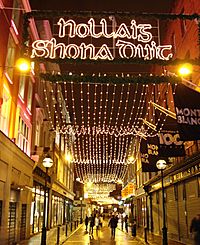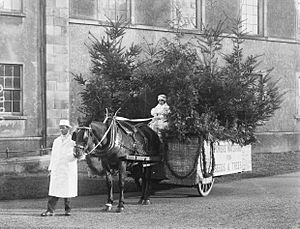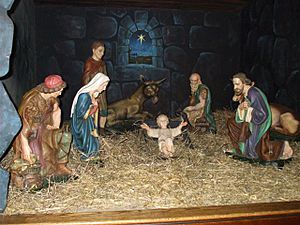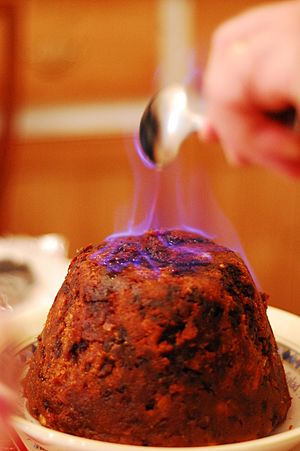Christmas in Ireland facts for kids
Quick facts for kids Christmas in Ireland |
|
|---|---|

Christmas lights in Dublin, 2007
|
|
| Official name | Lá Nollag |
| Significance | marking the birth of Jesus |
| Celebrations | Christmas tree decorations, church services |
| Begins | 8 December |
| Ends | 6 January |
| Date | 25 December |
| Next time | 25 December 2025 |
| Frequency | annual |
| Related to | Advent |
Christmas in Ireland is a special time of year. It celebrates the birth of Jesus for Christians. It also includes older traditions from before Christianity.
These traditions involve special foods, drinks, and decorations. There are also newer customs, like the Christmas Day swim. Today, Christmas in Ireland is much like celebrations in Britain and America. People focus a lot on buying gifts and having parties.
For Irish Catholics, the Christmas season used to start on 8 December. This day is called the Feast of the Immaculate Conception. Many people would put up their decorations and Christmas trees then. The season would last until 6 January, also known as Little Christmas.
Nowadays, many people feel Christmas starts with The Late Late Toy Show. This popular TV show airs on the last Friday of November.
To say "Happy Christmas" in Irish, you say Nollaig Shona Duit. This means "Happy Christmas to you."
Contents
Irish Christmas Traditions
Ireland is mostly a Christian country. So, Christmas is very important in religious life. It took the place of an older festival celebrated during the winter solstice. The first time Christmas was celebrated in Ireland was in 1171. This was when King Henry II spent Christmas in Dublin.
People traditionally attend church services for Christmas Day and Christmas Eve. Midnight Mass is a popular choice for many Catholics. There was also an early morning Christmas Day mass. Even people who did not go to church often were expected to attend on Christmas.
Christmas is also a time to remember those who have passed away. Prayers are said for them at Mass. It is common to decorate graves at Christmas. People use wreaths made of holly, ivy, or other evergreens. It was once believed that if someone died between Christmas Day and Little Christmas (6 January), they would go straight to heaven.
Christmas Day was sometimes called "Big Christmas" or Nollaig Mhór. This helped tell it apart from Little Christmas. In some parts of Ulster, men would gather for an event called a "join." They would share the cost of food and drinks. They celebrated at any time during the 10 days of Christmas.
Decorations
From the mid-1800s to the mid-1900s, Irish homes were cleaned for Christmas. This included cleaning and whitewashing the house. Decorating happened after this. Every part of the house was cleaned, from furniture to the chimney.
Evergreen plants like holly were used to decorate. They represented Christ and everlasting life. This tradition also has older, non-Christian roots. People would sell paper decorations and "mottoes" door-to-door. They also sold them at town markets. In Munster, people made decorations from holly sprigs on a simple wooden cross.
In rural homes, animal shelters like cow-sheds and stables were decorated. This honored the animals' role in the nativity story. Some people in Ireland believed that at midnight on Christmas Eve, animals like cows and donkeys could speak. They would say prayers in human voices. Hearing a rooster crow at midnight on Christmas Eve was thought to be good luck. Rural Irish homes also got a large log, like a Yule log. It was called bloc na Nollaig.
Mistletoe was not a traditional Irish Christmas decoration. It does not grow commonly in Ireland. However, it has become popular in modern times. Some areas, like County Armagh, did have the tradition of kissing under the mistletoe.
Christmas trees became popular in Ireland during the time of Queen Victoria. Their use grew from the 1840s onwards. Before this, people used a large branch or the top of a tree. Christmas trees are often put up on 8 December. This is because of a Christian tradition about the Immaculate Conception. In towns and cities, large trees are put up in central places with lights.
Many Irish homes have a traditional crib and a Christmas tree. Cribs are usually made of wood or plaster. The figure of baby Jesus is traditionally added to the crib on Christmas morning. The three wise men are placed in the scene on Little Christmas.
Leaving decorations up after 6 January was thought to bring bad luck. All the holly used for decorations would be burned. Local Catholic churches often have a large crib display during the Advent period. Taking a few strands of straw from a church crib was thought to bring good luck. People with thatched roofs would add the straw to their roofs. Since the late 1900s, crib displays are also put in public places. The Dublin "Moving Crib" at the Mansion House, with live animals, is very famous.
Santa Claus
Santa Claus, called Daidí na Nollag (meaning "father of Christmas") in Irish, is known as Santy or Santa in Ireland. He brings presents to children. These gifts are opened on Christmas morning. It is common to leave a mince pie and a bottle or glass of Guinness for Santa. A carrot is left for Rudolph.
Most big shopping centers have a Santa's grotto. This is set up from late November. Children can visit Santa there and tell him what they want for Christmas.
Christmas Candle
Placing a lighted candle in a window on Christmas Eve is still a tradition. This is also called Coinneal Mór na Nollag. It is placed at the window to welcome people needing shelter. Its main purpose is to welcome Mary and Joseph. In some homes, the youngest child or the mother lights the candle.
In many parts of Ireland, including County Armagh, the door was also left unlocked. Some areas traditionally lit three candles, representing the Holy Family. If a candle went out by accident, it was seen as a bad sign. Before electricity in rural areas, these candles lit up the night. The tradition continues today, often using an electric light instead of a candle.
Christmas Swim
Since the late 1900s, it has become common to swim in the sea on Christmas morning. This is often done to raise money for charity. The Forty Foot in Sandycove in Dublin and Blackrock in Salthill, Galway, are popular spots. Hundreds of people brave the cold water and jump into the sea.
Christmas Dinner
On Christmas Eve, fish is traditionally eaten. This is a way of fasting before Christmas. From the mid-1800s to the 1900s, Irish families spent weeks "getting in the Christmas." They slowly bought all the food and supplies for the holiday.
In rural areas, local shopkeepers would give loyal customers a "Christmas box." This gift often included a Christmas candle and a "Christmas jug." The jug was a china jug full of jam. This tradition mostly faded after World War II. But it still exists in some areas, with items like calendars or vouchers.
While Christmas dinner was being made, men and boys often played hurling. In other areas, like Ulster, people had shooting matches and went hunting.
The traditional Christmas dinner included boiled, spiced, roast beef, a roast goose, and ham. It came with vegetables and roast potatoes. Beef was the most popular Christmas meat in Ulster until the 1900s. Boiled ox-head was popular in Counties Armagh, Monaghan, and Tyrone. Cooking a turkey is a newer tradition from other countries. People also have a round cake with caraway seeds.
Dessert often included many dishes. Christmas pudding is a traditional choice. Brandy is sometimes poured over it and set alight. Like the Christmas tree, plum pudding and mince pies are thought to have come to Ireland from England. It was considered bad luck to cut the pudding before Christmas Day. If the pudding broke while cooking, it was believed the baker would die before the next Christmas.
In County Wexford, a traditional dish called "cuttlin pudding" was made on Christmas Eve. In County Donegal, pies shaped like cradles (to represent the manger) were traditional. Other desserts include Christmas cake, sherry trifle, yule log, and mince pies with sauces like brandy butter.
Thousands of tins of biscuits are bought and eaten. The Afternoon Tea variety is very popular. Chocolate selection boxes are also common gifts at Christmas.
After Christmas Day
St Stephen's Day is marked by wren boys visiting homes. They collect money for a "wren party." Christians traditionally fast on St Stephen's Day to honor the saint. Both Ireland and Northern Ireland have mummers' plays. These are similar to wren boys but different. Participants say rhymes for "treats" in the two weeks before Christmas.
Christmas celebrations in Ireland end on 6 January. This day is known as Women's Christmas (Nollaig na mBan), Little Christmas, or Epiphany. People take down their Christmas decorations then. The time between Christmas Day and Little Christmas was called "between the two Christmases." It was a popular time for people to meet and get to know each other, as it was a period of free time. It was believed that only snow that fell during this time would stay on the ground.
Television came to Ireland on New Year's Eve 1961.
Homecoming
Adult children often return home for Christmas. They usually come back on Christmas Eve. Those who had moved away often sent gifts or money home. This was sometimes called the "American letter." Since the 1980s, more Irish people living abroad have returned to Ireland for Christmas. Travel prices increased a lot in 2020. This was due to travel rules easing during the COVID-19 pandemic.
Christmas Spending
In 2015, a survey found that many people use their monthly income for Christmas. Others use savings or borrow money to cover costs.
The big traditional Christmas shopping day used to be 8 December. Many schools would close for the Catholic Feast of the Immaculate Conception. People from rural areas would go to towns and cities to do their Christmas shopping. This tradition started in the 1940s. The department store Clerys offered refunds on train tickets if customers spent more than £5. With online shopping and other popular shopping days like Black Friday, 8 December is no longer as busy for shopping.
Holiday Period
Traditionally, the holiday period ran from Christmas Day until 6 January. Christmas Day and St. Stephen's Day (or Boxing Day) are public holidays. Many people do not go back to work until the weekday after New Year's Day.
Many large companies close the day before Christmas Eve. They reopen the day after New Year's Day. Shop and public service workers usually return to work the day after St. Stephen's Day. Sometimes they work on St. Stephen's Day if Christmas sales have started.
Christmas in the Media
The Late Late Toy Show
The Late Late Toy Show is a special yearly episode of The Late Late Show. It airs on RTÉ One, usually on the last Friday of November. The show features the most popular toys of the year. It is often the most-watched TV program in Ireland each year. It is broadcast live, so anything can happen!
The studio audience is made up of adults dressed in Christmas clothes. The show does not accept toy advertisements during its breaks. Even if new gadget toys break down during the live show, being featured on the program greatly boosts their sales. The presenter's Christmas jumper is also a big topic of discussion before and after the show.
Radio
Joe Duffy's walk around Grafton Street, Dublin, is a yearly tradition. It is broadcast by RTÉ Radio 1 on Christmas Eve. RTÉ 2fm DJ Dave Fanning counts down his "Fanning's Fab 50 Christmas Trance Tunes." This is a listener music poll each year before Christmas. U2 is often very popular in this poll. From 2008, Christmas FM broadcasts Christmas songs non-stop until 26 December.
Christmas Music
"Fairytale of New York" was voted the most popular song for drivers in the Republic of Ireland in 2009. "Happy Xmas" topped a similar poll in Northern Ireland. The Christmas music of British singer Cliff Richard is most popular with people over 55.





